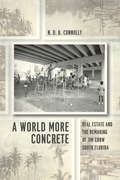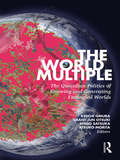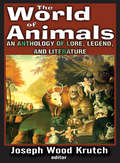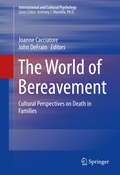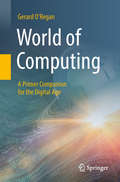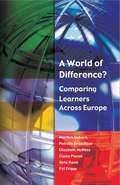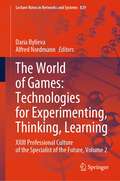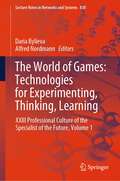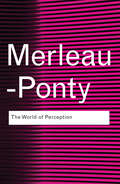- Table View
- List View
The World Is Always Coming to an End: Pulling Together and Apart in a Chicago Neighborhood (Chicago Visions and Revisions)
by Carlo RotellaAn urban neighborhood remakes itself every day—and unmakes itself, too. Houses and stores and streets define it in one way. But it’s also people—the people who make it their home, some eagerly, others grudgingly. A neighborhood can thrive or it can decline, and neighbors move in and move out. Sometimes they stay but withdraw behind fences and burglar alarms. If a neighborhood becomes no longer a place of sociability and street life, but of privacy indoors and fearful distrust outdoors, is it still a neighborhood? In the late 1960s and 1970s Carlo Rotella grew up in Chicago’s South Shore neighborhood—a place of neat bungalow blocks and desolate commercial strips, and sharp, sometimes painful social contrasts. In the decades since, the hollowing out of the middle class has left residents confronting—or avoiding—each other across an expanding gap that makes it ever harder for them to recognize each other as neighbors. Rotella tells the stories that reveal how that happened—stories of deindustrialization and street life; stories of gorgeous apartments with vistas onto Lake Michigan and of Section 8 housing vouchers held by the poor. At every turn, South Shore is a study in contrasts, shaped and reshaped over the past half-century by individual stories and larger waves of change that make it an exemplar of many American urban neighborhoods. Talking with current and former residents and looking carefully at the interactions of race and class, persistence and change, Rotella explores the tension between residents’ deep investment of feeling and resources in the physical landscape of South Shore and their hesitation to make a similar commitment to the community of neighbors living there. Blending journalism, memoir, and archival research, The World Is Always Coming to an End uses the story of one American neighborhood to challenge our assumptions about what neighborhoods are, and to think anew about what they might be if we can bridge gaps and commit anew to the people who share them with us. Tomorrow is another ending.
The World Is Always Coming to an End: Pulling Together and Apart in a Chicago Neighborhood (Chicago Visions and Revisions)
by Carlo RotellaAn urban neighborhood remakes itself every day—and unmakes itself, too. Houses and stores and streets define it in one way. But it’s also people—the people who make it their home, some eagerly, others grudgingly. A neighborhood can thrive or it can decline, and neighbors move in and move out. Sometimes they stay but withdraw behind fences and burglar alarms. If a neighborhood becomes no longer a place of sociability and street life, but of privacy indoors and fearful distrust outdoors, is it still a neighborhood? In the late 1960s and 1970s Carlo Rotella grew up in Chicago’s South Shore neighborhood—a place of neat bungalow blocks and desolate commercial strips, and sharp, sometimes painful social contrasts. In the decades since, the hollowing out of the middle class has left residents confronting—or avoiding—each other across an expanding gap that makes it ever harder for them to recognize each other as neighbors. Rotella tells the stories that reveal how that happened—stories of deindustrialization and street life; stories of gorgeous apartments with vistas onto Lake Michigan and of Section 8 housing vouchers held by the poor. At every turn, South Shore is a study in contrasts, shaped and reshaped over the past half-century by individual stories and larger waves of change that make it an exemplar of many American urban neighborhoods. Talking with current and former residents and looking carefully at the interactions of race and class, persistence and change, Rotella explores the tension between residents’ deep investment of feeling and resources in the physical landscape of South Shore and their hesitation to make a similar commitment to the community of neighbors living there. Blending journalism, memoir, and archival research, The World Is Always Coming to an End uses the story of one American neighborhood to challenge our assumptions about what neighborhoods are, and to think anew about what they might be if we can bridge gaps and commit anew to the people who share them with us. Tomorrow is another ending.
The World Is Always Coming to an End: Pulling Together and Apart in a Chicago Neighborhood (Chicago Visions and Revisions)
by Carlo RotellaAn urban neighborhood remakes itself every day—and unmakes itself, too. Houses and stores and streets define it in one way. But it’s also people—the people who make it their home, some eagerly, others grudgingly. A neighborhood can thrive or it can decline, and neighbors move in and move out. Sometimes they stay but withdraw behind fences and burglar alarms. If a neighborhood becomes no longer a place of sociability and street life, but of privacy indoors and fearful distrust outdoors, is it still a neighborhood? In the late 1960s and 1970s Carlo Rotella grew up in Chicago’s South Shore neighborhood—a place of neat bungalow blocks and desolate commercial strips, and sharp, sometimes painful social contrasts. In the decades since, the hollowing out of the middle class has left residents confronting—or avoiding—each other across an expanding gap that makes it ever harder for them to recognize each other as neighbors. Rotella tells the stories that reveal how that happened—stories of deindustrialization and street life; stories of gorgeous apartments with vistas onto Lake Michigan and of Section 8 housing vouchers held by the poor. At every turn, South Shore is a study in contrasts, shaped and reshaped over the past half-century by individual stories and larger waves of change that make it an exemplar of many American urban neighborhoods. Talking with current and former residents and looking carefully at the interactions of race and class, persistence and change, Rotella explores the tension between residents’ deep investment of feeling and resources in the physical landscape of South Shore and their hesitation to make a similar commitment to the community of neighbors living there. Blending journalism, memoir, and archival research, The World Is Always Coming to an End uses the story of one American neighborhood to challenge our assumptions about what neighborhoods are, and to think anew about what they might be if we can bridge gaps and commit anew to the people who share them with us. Tomorrow is another ending.
The World Is Always Coming to an End: Pulling Together and Apart in a Chicago Neighborhood (Chicago Visions and Revisions)
by Carlo RotellaAn urban neighborhood remakes itself every day—and unmakes itself, too. Houses and stores and streets define it in one way. But it’s also people—the people who make it their home, some eagerly, others grudgingly. A neighborhood can thrive or it can decline, and neighbors move in and move out. Sometimes they stay but withdraw behind fences and burglar alarms. If a neighborhood becomes no longer a place of sociability and street life, but of privacy indoors and fearful distrust outdoors, is it still a neighborhood? In the late 1960s and 1970s Carlo Rotella grew up in Chicago’s South Shore neighborhood—a place of neat bungalow blocks and desolate commercial strips, and sharp, sometimes painful social contrasts. In the decades since, the hollowing out of the middle class has left residents confronting—or avoiding—each other across an expanding gap that makes it ever harder for them to recognize each other as neighbors. Rotella tells the stories that reveal how that happened—stories of deindustrialization and street life; stories of gorgeous apartments with vistas onto Lake Michigan and of Section 8 housing vouchers held by the poor. At every turn, South Shore is a study in contrasts, shaped and reshaped over the past half-century by individual stories and larger waves of change that make it an exemplar of many American urban neighborhoods. Talking with current and former residents and looking carefully at the interactions of race and class, persistence and change, Rotella explores the tension between residents’ deep investment of feeling and resources in the physical landscape of South Shore and their hesitation to make a similar commitment to the community of neighbors living there. Blending journalism, memoir, and archival research, The World Is Always Coming to an End uses the story of one American neighborhood to challenge our assumptions about what neighborhoods are, and to think anew about what they might be if we can bridge gaps and commit anew to the people who share them with us. Tomorrow is another ending.
The World is Out of Joint: World-Historical Interpretations of Continuing Polarizations
by Immanuel WallersteinThe dominant view in social science has been that the modern world shows a pattern of linear development in which all positive social trends rise (albeit at an uncertain speed) toward a relatively homogenized world. In the post-1945 period, some analysts contested this linear model, arguing that the modern world was rather one of escalating polarization. Their view was strengthened by the separate emergence within the natural sciences of complexity studies, which suggested that natural systems inevitably moved away from equilibrium, and at a certain point bifurcated radically.This book, based on a truly collaborative international research project, evaluates the empirical evidence in this debate in order to (1) give an adequate portrayal of the historical realities of the world-system, (2) draw a nuanced assessment about this debate, and (3) provide the basis on which we can not only envisage probable future trends but also draw conclusions about the policy and/or political implications of past and future research.The work of ten research clusters, based on crucial topics of overlapping nodes of social activity, provides a vantage-point with which to assess the basic issue; a clear picture emerges of "world-historical interpretations of continuing polarizations."
The World is Out of Joint: World-Historical Interpretations of Continuing Polarizations
by Immanuel WallersteinThe dominant view in social science has been that the modern world shows a pattern of linear development in which all positive social trends rise (albeit at an uncertain speed) toward a relatively homogenized world. In the post-1945 period, some analysts contested this linear model, arguing that the modern world was rather one of escalating polarization. Their view was strengthened by the separate emergence within the natural sciences of complexity studies, which suggested that natural systems inevitably moved away from equilibrium, and at a certain point bifurcated radically.This book, based on a truly collaborative international research project, evaluates the empirical evidence in this debate in order to (1) give an adequate portrayal of the historical realities of the world-system, (2) draw a nuanced assessment about this debate, and (3) provide the basis on which we can not only envisage probable future trends but also draw conclusions about the policy and/or political implications of past and future research.The work of ten research clusters, based on crucial topics of overlapping nodes of social activity, provides a vantage-point with which to assess the basic issue; a clear picture emerges of "world-historical interpretations of continuing polarizations."
A World Laid Waste?: Responding to the Social, Cultural and Political Consequences of Globalisation (CRESC)
by Francis Dodsworth Antonia WalfordGlobalisation and neo-liberalism have seen the rise of new international powers, increasingly interlinked economies, and mass urbanisation. The internet, mobile communications and mass migration have transformed lives around the planet. For some, this has been positive and liberating, but it has also been destructive of settled communities and ways of living, ecologies, economies and livelihoods, cultural values, political programmes and identities. This edited volume uses the concept of waste to explore and critique the destructive impact of globalisation and neo-liberalism. By bringing to bear the distinct perspectives of sociologists of class, religion and culture; anthropologists concerned with infrastructures, material waste and energy; and analysts from accounting and finance exploring financialization and supply chains, this collection explores how creative responses to the wastelands of globalisation can establish alternative, at times fragile, narratives of hope. Responding to the tendency in contemporary public and academic discourse to resort to a language of the ‘laid to waste’ or ‘left behind’ to make sense of social and cultural change, the authors of this volume focus on the practices and rhetorics of waste in a range of different empirical settings to reveal the spaces for political action and social imagination that are emerging even in times of polarisation, uncertainty and disillusionment. This inter-disciplinary approach, developed through a decade of research in the ESRC Centre for Research on Socio-Cultural Change (CRESC), provides a distinctive perspective on the ways in which people in very different social and cultural contexts are negotiating the destructive and creative possibilities of recent political and economic change.
A World Laid Waste?: Responding to the Social, Cultural and Political Consequences of Globalisation (CRESC)
by Francis Dodsworth Antonia WalfordGlobalisation and neo-liberalism have seen the rise of new international powers, increasingly interlinked economies, and mass urbanisation. The internet, mobile communications and mass migration have transformed lives around the planet. For some, this has been positive and liberating, but it has also been destructive of settled communities and ways of living, ecologies, economies and livelihoods, cultural values, political programmes and identities. This edited volume uses the concept of waste to explore and critique the destructive impact of globalisation and neo-liberalism. By bringing to bear the distinct perspectives of sociologists of class, religion and culture; anthropologists concerned with infrastructures, material waste and energy; and analysts from accounting and finance exploring financialization and supply chains, this collection explores how creative responses to the wastelands of globalisation can establish alternative, at times fragile, narratives of hope. Responding to the tendency in contemporary public and academic discourse to resort to a language of the ‘laid to waste’ or ‘left behind’ to make sense of social and cultural change, the authors of this volume focus on the practices and rhetorics of waste in a range of different empirical settings to reveal the spaces for political action and social imagination that are emerging even in times of polarisation, uncertainty and disillusionment. This inter-disciplinary approach, developed through a decade of research in the ESRC Centre for Research on Socio-Cultural Change (CRESC), provides a distinctive perspective on the ways in which people in very different social and cultural contexts are negotiating the destructive and creative possibilities of recent political and economic change.
A World More Concrete: Real Estate and the Remaking of Jim Crow South Florida (Historical Studies of Urban America)
by N. D. ConnollyMany people characterize urban renewal projects and the power of eminent domain as two of the most widely despised and often racist tools for reshaping American cities in the postwar period. In A World More Concrete, N. D. B. Connolly uses the history of South Florida to unearth an older and far more complex story. Connolly captures nearly eighty years of political and land transactions to reveal how real estate and redevelopment created and preserved metropolitan growth and racial peace under white supremacy. Using a materialist approach, he offers a long view of capitalism and the color line, following much of the money that made land taking and Jim Crow segregation profitable and preferred approaches to governing cities throughout the twentieth century. A World More Concrete argues that black and white landlords, entrepreneurs, and even liberal community leaders used tenements and repeated land dispossession to take advantage of the poor and generate remarkable wealth. Through a political culture built on real estate, South Florida’s landlords and homeowners advanced property rights and white property rights, especially, at the expense of more inclusive visions of equality. For black people and many of their white allies, uses of eminent domain helped to harden class and color lines. Yet, for many reformers, confiscating certain kinds of real estate through eminent domain also promised to help improve housing conditions, to undermine the neighborhood influence of powerful slumlords, and to open new opportunities for suburban life for black Floridians. Concerned more with winners and losers than with heroes and villains, A World More Concrete offers a sober assessment of money and power in Jim Crow America. It shows how negotiations between powerful real estate interests on both sides of the color line gave racial segregation a remarkable capacity to evolve, revealing property owners’ power to reshape American cities in ways that can still be seen and felt today.
A World More Concrete: Real Estate and the Remaking of Jim Crow South Florida (Historical Studies of Urban America)
by N. D. ConnollyMany people characterize urban renewal projects and the power of eminent domain as two of the most widely despised and often racist tools for reshaping American cities in the postwar period. In A World More Concrete, N. D. B. Connolly uses the history of South Florida to unearth an older and far more complex story. Connolly captures nearly eighty years of political and land transactions to reveal how real estate and redevelopment created and preserved metropolitan growth and racial peace under white supremacy. Using a materialist approach, he offers a long view of capitalism and the color line, following much of the money that made land taking and Jim Crow segregation profitable and preferred approaches to governing cities throughout the twentieth century. A World More Concrete argues that black and white landlords, entrepreneurs, and even liberal community leaders used tenements and repeated land dispossession to take advantage of the poor and generate remarkable wealth. Through a political culture built on real estate, South Florida’s landlords and homeowners advanced property rights and white property rights, especially, at the expense of more inclusive visions of equality. For black people and many of their white allies, uses of eminent domain helped to harden class and color lines. Yet, for many reformers, confiscating certain kinds of real estate through eminent domain also promised to help improve housing conditions, to undermine the neighborhood influence of powerful slumlords, and to open new opportunities for suburban life for black Floridians. Concerned more with winners and losers than with heroes and villains, A World More Concrete offers a sober assessment of money and power in Jim Crow America. It shows how negotiations between powerful real estate interests on both sides of the color line gave racial segregation a remarkable capacity to evolve, revealing property owners’ power to reshape American cities in ways that can still be seen and felt today.
A World More Concrete: Real Estate and the Remaking of Jim Crow South Florida (Historical Studies of Urban America)
by N. D. ConnollyMany people characterize urban renewal projects and the power of eminent domain as two of the most widely despised and often racist tools for reshaping American cities in the postwar period. In A World More Concrete, N. D. B. Connolly uses the history of South Florida to unearth an older and far more complex story. Connolly captures nearly eighty years of political and land transactions to reveal how real estate and redevelopment created and preserved metropolitan growth and racial peace under white supremacy. Using a materialist approach, he offers a long view of capitalism and the color line, following much of the money that made land taking and Jim Crow segregation profitable and preferred approaches to governing cities throughout the twentieth century. A World More Concrete argues that black and white landlords, entrepreneurs, and even liberal community leaders used tenements and repeated land dispossession to take advantage of the poor and generate remarkable wealth. Through a political culture built on real estate, South Florida’s landlords and homeowners advanced property rights and white property rights, especially, at the expense of more inclusive visions of equality. For black people and many of their white allies, uses of eminent domain helped to harden class and color lines. Yet, for many reformers, confiscating certain kinds of real estate through eminent domain also promised to help improve housing conditions, to undermine the neighborhood influence of powerful slumlords, and to open new opportunities for suburban life for black Floridians. Concerned more with winners and losers than with heroes and villains, A World More Concrete offers a sober assessment of money and power in Jim Crow America. It shows how negotiations between powerful real estate interests on both sides of the color line gave racial segregation a remarkable capacity to evolve, revealing property owners’ power to reshape American cities in ways that can still be seen and felt today.
A World More Concrete: Real Estate and the Remaking of Jim Crow South Florida (Historical Studies of Urban America)
by N. D. ConnollyMany people characterize urban renewal projects and the power of eminent domain as two of the most widely despised and often racist tools for reshaping American cities in the postwar period. In A World More Concrete, N. D. B. Connolly uses the history of South Florida to unearth an older and far more complex story. Connolly captures nearly eighty years of political and land transactions to reveal how real estate and redevelopment created and preserved metropolitan growth and racial peace under white supremacy. Using a materialist approach, he offers a long view of capitalism and the color line, following much of the money that made land taking and Jim Crow segregation profitable and preferred approaches to governing cities throughout the twentieth century. A World More Concrete argues that black and white landlords, entrepreneurs, and even liberal community leaders used tenements and repeated land dispossession to take advantage of the poor and generate remarkable wealth. Through a political culture built on real estate, South Florida’s landlords and homeowners advanced property rights and white property rights, especially, at the expense of more inclusive visions of equality. For black people and many of their white allies, uses of eminent domain helped to harden class and color lines. Yet, for many reformers, confiscating certain kinds of real estate through eminent domain also promised to help improve housing conditions, to undermine the neighborhood influence of powerful slumlords, and to open new opportunities for suburban life for black Floridians. Concerned more with winners and losers than with heroes and villains, A World More Concrete offers a sober assessment of money and power in Jim Crow America. It shows how negotiations between powerful real estate interests on both sides of the color line gave racial segregation a remarkable capacity to evolve, revealing property owners’ power to reshape American cities in ways that can still be seen and felt today.
A World More Concrete: Real Estate and the Remaking of Jim Crow South Florida (Historical Studies of Urban America)
by N. D. ConnollyMany people characterize urban renewal projects and the power of eminent domain as two of the most widely despised and often racist tools for reshaping American cities in the postwar period. In A World More Concrete, N. D. B. Connolly uses the history of South Florida to unearth an older and far more complex story. Connolly captures nearly eighty years of political and land transactions to reveal how real estate and redevelopment created and preserved metropolitan growth and racial peace under white supremacy. Using a materialist approach, he offers a long view of capitalism and the color line, following much of the money that made land taking and Jim Crow segregation profitable and preferred approaches to governing cities throughout the twentieth century. A World More Concrete argues that black and white landlords, entrepreneurs, and even liberal community leaders used tenements and repeated land dispossession to take advantage of the poor and generate remarkable wealth. Through a political culture built on real estate, South Florida’s landlords and homeowners advanced property rights and white property rights, especially, at the expense of more inclusive visions of equality. For black people and many of their white allies, uses of eminent domain helped to harden class and color lines. Yet, for many reformers, confiscating certain kinds of real estate through eminent domain also promised to help improve housing conditions, to undermine the neighborhood influence of powerful slumlords, and to open new opportunities for suburban life for black Floridians. Concerned more with winners and losers than with heroes and villains, A World More Concrete offers a sober assessment of money and power in Jim Crow America. It shows how negotiations between powerful real estate interests on both sides of the color line gave racial segregation a remarkable capacity to evolve, revealing property owners’ power to reshape American cities in ways that can still be seen and felt today.
A World More Concrete: Real Estate and the Remaking of Jim Crow South Florida (Historical Studies of Urban America)
by N. D. ConnollyMany people characterize urban renewal projects and the power of eminent domain as two of the most widely despised and often racist tools for reshaping American cities in the postwar period. In A World More Concrete, N. D. B. Connolly uses the history of South Florida to unearth an older and far more complex story. Connolly captures nearly eighty years of political and land transactions to reveal how real estate and redevelopment created and preserved metropolitan growth and racial peace under white supremacy. Using a materialist approach, he offers a long view of capitalism and the color line, following much of the money that made land taking and Jim Crow segregation profitable and preferred approaches to governing cities throughout the twentieth century. A World More Concrete argues that black and white landlords, entrepreneurs, and even liberal community leaders used tenements and repeated land dispossession to take advantage of the poor and generate remarkable wealth. Through a political culture built on real estate, South Florida’s landlords and homeowners advanced property rights and white property rights, especially, at the expense of more inclusive visions of equality. For black people and many of their white allies, uses of eminent domain helped to harden class and color lines. Yet, for many reformers, confiscating certain kinds of real estate through eminent domain also promised to help improve housing conditions, to undermine the neighborhood influence of powerful slumlords, and to open new opportunities for suburban life for black Floridians. Concerned more with winners and losers than with heroes and villains, A World More Concrete offers a sober assessment of money and power in Jim Crow America. It shows how negotiations between powerful real estate interests on both sides of the color line gave racial segregation a remarkable capacity to evolve, revealing property owners’ power to reshape American cities in ways that can still be seen and felt today.
The World Multiple: The Quotidian Politics of Knowing and Generating Entangled Worlds (Routledge Advances in Sociology)
by Keiichi Omura Grant Jun Otsuki Shiho Satsuka Atsuro MoritaThe World Multiple, as a collection, is an ambitious ethnographic experiment in understanding how the world is experienced and generated in multiple ways through people’s everyday practices. Against the dominant assumption that the world is a single universal reality that can only be known by modern expert science, this book argues that worlds are worlded—they are socially and materially crafted in multiple forms in everyday practices involving humans, landscapes, animals, plants, fungi, rocks, and other beings. These practices do not converge to a singular knowledge of the world, but generate a world multiple—a world that is more than one integrated whole, yet less than many fragmented parts. The book brings together authors from Europe, Japan, and North America, in conversation with ethnographic material from Africa, the Americas, and Asia, in order to explore the possibilities of the world multiple to reveal new ways to intervene in the legacies of colonialism, imperialism, and capitalism that inflict damage on humans and nonhumans. The contributors show how the world is formed through interactions among techno-scientific, vernacular, local, and indigenous practices, and examine the new forms of politics that emerge out of them. Engaged with recent anthropological discussions of ontologies, the Anthropocene, and multi-species ethnography, the book addresses the multidimensional realities of people’s lives and the quotidian politics they entail.
The World Multiple: The Quotidian Politics of Knowing and Generating Entangled Worlds (Routledge Advances in Sociology)
by Keiichi Omura Shiho Satsuka Atsuro Morita Grant Jun OtsukiThe World Multiple, as a collection, is an ambitious ethnographic experiment in understanding how the world is experienced and generated in multiple ways through people’s everyday practices. Against the dominant assumption that the world is a single universal reality that can only be known by modern expert science, this book argues that worlds are worlded—they are socially and materially crafted in multiple forms in everyday practices involving humans, landscapes, animals, plants, fungi, rocks, and other beings. These practices do not converge to a singular knowledge of the world, but generate a world multiple—a world that is more than one integrated whole, yet less than many fragmented parts. The book brings together authors from Europe, Japan, and North America, in conversation with ethnographic material from Africa, the Americas, and Asia, in order to explore the possibilities of the world multiple to reveal new ways to intervene in the legacies of colonialism, imperialism, and capitalism that inflict damage on humans and nonhumans. The contributors show how the world is formed through interactions among techno-scientific, vernacular, local, and indigenous practices, and examine the new forms of politics that emerge out of them. Engaged with recent anthropological discussions of ontologies, the Anthropocene, and multi-species ethnography, the book addresses the multidimensional realities of people’s lives and the quotidian politics they entail.
The World of Animals: An Anthology of Lore, Legend, and Literature
by Joseph KrutchHuman beings share the earth with many other living creatures and have dealt with them in many different ways. Animals have furnished humans with food, done their work, aroused their curiosity, provided them with "sport," stimulated their sense of beauty, and provoked their wonder. They have also shared affection, when both the human and animal have decided to give it. No less varied or avoidable are the attitudes humans have developed toward these creatures.This collection of writings selected from a vast literature about animals is also about the people who have been inspired to write on that subject. Sometimes consciously and sometimes unconsciously the writer implies an answer to one or more of the questions that any concern with an animal must raise, such as: What is an animal's place in nature? Are they here primarily to serve as a food source? Do they possess inherent rights and privileges? How are they alike or different from humans? The answers to these questions are as varied as the authors. Each narrative description, or exposition contributes something to an over-all picture of human beings' relations with and attitudes toward the animal kingdom.It is a remarkable conclusion, illustrated by Krutch's chronological arrangement within categories, that almost every major attitude and activity that has ever existed concerning animals still exists today even though there has been a drift in certain directions. Although the editor fairly represents the opposing view, his sympathies lie with those for whom the animal world embodies something to be loved and learned from rather than merely to be studied or exploited.
The World of Animals: An Anthology of Lore, Legend, and Literature
by Joseph Wood KrutchHuman beings share the earth with many other living creatures and have dealt with them in many different ways. Animals have furnished humans with food, done their work, aroused their curiosity, provided them with "sport," stimulated their sense of beauty, and provoked their wonder. They have also shared affection, when both the human and animal have decided to give it. No less varied or avoidable are the attitudes humans have developed toward these creatures.This collection of writings selected from a vast literature about animals is also about the people who have been inspired to write on that subject. Sometimes consciously and sometimes unconsciously the writer implies an answer to one or more of the questions that any concern with an animal must raise, such as: What is an animal's place in nature? Are they here primarily to serve as a food source? Do they possess inherent rights and privileges? How are they alike or different from humans? The answers to these questions are as varied as the authors. Each narrative description, or exposition contributes something to an over-all picture of human beings' relations with and attitudes toward the animal kingdom.It is a remarkable conclusion, illustrated by Krutch's chronological arrangement within categories, that almost every major attitude and activity that has ever existed concerning animals still exists today even though there has been a drift in certain directions. Although the editor fairly represents the opposing view, his sympathies lie with those for whom the animal world embodies something to be loved and learned from rather than merely to be studied or exploited.
The World of Bereavement: Cultural Perspectives on Death in Families (International and Cultural Psychology)
by Joanne Cacciatore John DeFrainThis visionary work explores the sensitive balance between the personal and private aspects of grief, the social and cultural variables that unite communities in bereavement, and the universal experience of loss. Its global journey takes readers into the processes of coping, ritual, and belief across established and emerging nations, indigenous cultures, and countries undergoing major upheavals, richly detailed by native scholars and practitioners. In these pages, culture itself is recognized as formed through many lenses, from the ancestral to the experiential. The human capacity to mourn, endure, and make meaning is examined in papers such as: Death, grief, and culture in Kenya: experiential strengths-based research. Death and grief in Korea: the continuum of life and death.To live with death: loss in Romanian culture.The Brazilian ways of living, dying, and grieving.Death and bereavement in Israel: Jewish, Muslim, and Christian perspectives.Completing the circle of life: death and grief among Native Americans.It is always normal to remember: death, grief, and culture in Australia.The World of Bereavement will fascinate and inspire clinicians, providers, and researchers in the field of death studies as well as privately-held professional training programs and the bereavement community in general.
World of Computing: A Primer Companion for the Digital Age
by Gerard O'ReganThis engaging work provides a concise introduction to the exciting world of computing, encompassing the theory, technology, history, and societal impact of computer software and computing devices. Spanning topics from global conflict to home gaming, international business, and human communication, this text reviews the key concepts unpinning the technology which has shaped the modern world.Topics and features: introduces the foundations of computing, the fundamentals of algorithms, and the essential concepts from mathematics and logic used in computer science; presents a concise history of computing, discussing the historical figures who made important contributions, and the machines which formed major milestones; examines the fields of human−computer interaction, and software engineering; provides accessible introductions to the core aspects of programming languages, operating systems, and databases; describes the Internet revolution, the invention of the smartphone, and the rise of social media, as well as the Internet of Things and cryptocurrencies; explores legal and ethical aspects of computing, including issues of hacking and cybercrime, and the nature of online privacy, free speech and censorship; discusses such innovations as distributed systems, service-oriented architecture, software as a service, cloud computing, and embedded systems; includes key learning topics and review questions in every chapter, and a helpful glossary.Offering an enjoyable overview of the fascinating and broad-ranging field of computing, this easy-to-understand primer introduces the general reader to the ideas on which the digital world was built, and the historical developments that helped to form the modern age.
A World of Difference? (UK Higher Education OUP Humanities & Social Sciences Education OUP)
by Marilyn Osborn Patricia Broadfoot Elizabeth Mcness Birte Ravn Claire Planel Pat TriggsThis fascinating volume compares the experience of young learners in England, France and Denmark in order to examine the relationship between national educational cultures, individual biographies and classroom practices in creating the context for learning. It explores how secondary schools in three very different education systems work to develop the aptitudes and attitudes conducive to lifelong learning in conditions of complexity, uncertainty and multiple change. By drawing upon a rich data-set including questionnaires, individual and group interviews and classroom observation, the book gives a voice to young learners in the three countries. Through detailed case studies and quotations it examines their concerns with schooling, with teachers, with motivation and achievement and explores the very different social contexts which influence their engagement with learning.This book will be an essential resource for researchers, practitioners, students and policy-makers and all those committed to understanding the relationship between culture and learning and to improving secondary education.
The World of Games: XXIII Professional Culture of the Specialist of the Future, Volume 2 (Lecture Notes in Networks and Systems #829)
by Daria Bylieva Alfred NordmannThis book reflects the various dimensions of play. It gathers together experience with role-play, tabletop, and online games and develops and assesses tools. It also reflects the human condition in this world of games as it becomes a digital world. We are living in a World of Games where every game is a world through which we learn about the world. A World of Games is fun and engaging, but it also provides deceptive pleasures. What may seem like fun is far from harmless. And then there are the many ways of learning in the mode of play.
The World of Games: XXIII Professional Culture of the Specialist of the Future, Volume 1 (Lecture Notes in Networks and Systems #830)
by Daria Bylieva Alfred NordmannThis book reflects the various dimensions of play. It gathers together experience with role-play, tabletop, and online games and develops and assesses tools. It also reflects the human condition in this world of games as it becomes a digital world. We are living in a World of Games where every game is a world through which we learn about the world. A World of Games is fun and engaging, but it also provides deceptive pleasures. What may seem like fun is far from harmless. And then there are the many ways of learning in the mode of play.
The World of Perception
by Maurice Merleau-Ponty'In simple prose Merleau-Ponty touches on his principle themes. He speaks about the body and the world, the coexistence of space and things, the unfortunate optimism of science – and also the insidious stickiness of honey, and the mystery of anger.' - James ElkinsMaurice Merleau-Ponty was one of the most important thinkers of the post-war era. Central to his thought was the idea that human understanding comes from our bodily experience of the world that we perceive: a deceptively simple argument, perhaps, but one that he felt had to be made in the wake of attacks from contemporary science and the philosophy of Descartes on the reliability of human perception.From this starting point, Merleau-Ponty presented these seven lectures on The World of Perception to French radio listeners in 1948. Available in a paperback English translation for the first time in the Routledge Classics series to mark the centenary of Merleau-Ponty’s birth, this is a dazzling and accessible guide to a whole universe of experience, from the pursuit of scientific knowledge, through the psychic life of animals to the glories of the art of Paul Cézanne.
The World of Perception
by Maurice Merleau-Ponty'In simple prose Merleau-Ponty touches on his principle themes. He speaks about the body and the world, the coexistence of space and things, the unfortunate optimism of science – and also the insidious stickiness of honey, and the mystery of anger.' - James ElkinsMaurice Merleau-Ponty was one of the most important thinkers of the post-war era. Central to his thought was the idea that human understanding comes from our bodily experience of the world that we perceive: a deceptively simple argument, perhaps, but one that he felt had to be made in the wake of attacks from contemporary science and the philosophy of Descartes on the reliability of human perception.From this starting point, Merleau-Ponty presented these seven lectures on The World of Perception to French radio listeners in 1948. Available in a paperback English translation for the first time in the Routledge Classics series to mark the centenary of Merleau-Ponty’s birth, this is a dazzling and accessible guide to a whole universe of experience, from the pursuit of scientific knowledge, through the psychic life of animals to the glories of the art of Paul Cézanne.



